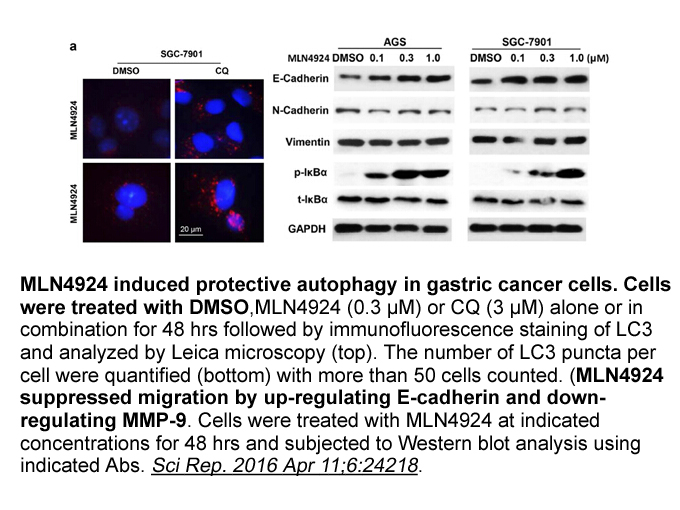Archives
Pilsicainide might increase hERG proteins via
Pilsicainide might increase hERG proteins via facilitating the transcription of hERG from DNA to RNA or the translation of hERG RNA into hERG protein. Qualitative RT-PCR demonstrated the absence of an increase in hERG mRNA expression levels after pilsicainide treatment (Supplemental Fig. S2), indicating that pilsicainide does not influence hERG transcription. Inhibition of the pilsicainide effect by E4031, a known chemical chaperon for hERG, suggests post-translational modifications, rather than accelerated translation, for the pilsicainide effect. Nevertheless, further experiments are necessary to confirm post-translational modifications by pilsicainide.
Chronic treatment with antiarrhythmic agents could induce post-translational modifications of ion eph receptor and exert pro- and anti-arrhythmic actions, independent of their acute actions on ion channels. For instance, some antiarrhythmic agents could modify Na+ channel activities via phosphorylation of Akt [17]. Phosphorylated Akt is well known to increase hERG channel currents [18]. In this study, however, chronic exposure to pilsicainide significantly enhanced the expression of WT-hERG proteins without phosphorylating Akt.
It has been reported that HSF-1, hsp70 and hsp90 increase both the mature and immature forms of WT and mutant hERG proteins, and also facilitate the maturation of mutant hERG proteins [15]. Local anesthetics induced hsp70 expression [19]; thus, pilsicainide may exert its effects via modulating these regulatory proteins. In the present study, however, pilsicainide did not influence the expression of HSF-1, hsp70 or hsp90, excluding the involvement of these regulators in the pilsicainide-induced enhancement of WT-hERG protein expressions.
The most prominent finding of this study is that pretreatment with E4031 abolishes the enhancement of WT-hERG protein expression by pilsicainide. Since E4031 is well known to increase WT-hERG protein levels as a chemical chaperone, the present finding suggests that pilsicainide acts on WT-hERG proteins as a chemical chaperone, like E4031. There are three possible mechanisms for the pilsicainide-induced increase of hERG proteins via post-translational modifications: (1) phosphorylation of Akt, (2) activation of hsp expressions, and (3) direct action as a chemical chaperone. Involvements of the Akt and hsp pathways have been denied by our experiments (Fig. 6). A chemical chaperone is defined as a chemical agent that binds to a target protein, stabilizes its structure, and delays its degradation. In our study, pilsicainide prolonged the half-life of hERG proteins, and the chemical chaperone E4031 canceled the enhancement of hERG protein expression by pilsicainide. Taken together, we conclude that pilsicainide acts as a chemical chaperone to increase hERG proteins with facilitation of their maturation.
Chronic treatment with pilsicainide at 0.03–10μM could stabilize WT-hERG proteins. The minimum effective concentration of pilsicainide for the action as a chemical chaperone was 0.3μM, which is far less than its therapeutic plasma concentrations of around 3μM [20]. The clinical relevance of the enhancing effects of pilsicainide on WT-hERG expression is clear; chronic treatment with pilsicainide could shorten the ventricular APD, because hERG channels are expressed predominantly in ventricular myocytes and significantly contribute to ventricular AP repolarization [1]. Thus, pilsicainide as a chemical chaperone will suppress early afterdepolarizations by increasing mutant hERG pr oteins and I in LQTS cardiomyocytes [21]. Augmentation
oteins and I in LQTS cardiomyocytes [21]. Augmentation  of I results in a shortening of APDs and a reduction of Ca2+ load in ventricular muscles, and might also suppress ventricular arrhythmias [20]. However, one limitation of this study is that our experiments were performed on the heterologous system of HEK293 cells but not on cardiomyocytes; thus, it is difficult to apply our findings directly to the heart. Further experiments will be necessary to confirm whether pilsicainide can increase hERG proteins and channel currents in cardiac myocytes.
of I results in a shortening of APDs and a reduction of Ca2+ load in ventricular muscles, and might also suppress ventricular arrhythmias [20]. However, one limitation of this study is that our experiments were performed on the heterologous system of HEK293 cells but not on cardiomyocytes; thus, it is difficult to apply our findings directly to the heart. Further experiments will be necessary to confirm whether pilsicainide can increase hERG proteins and channel currents in cardiac myocytes.